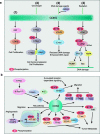Post-translational modifications of CDK5 and their biological roles in cancer
- PMID: 35006426
- PMCID: PMC8607427
- DOI: 10.1186/s43556-021-00029-0
Post-translational modifications of CDK5 and their biological roles in cancer
Abstract
Post-translational modifications (PTMs) of Cyclin-dependent kinase 5 (CDK5) have emerged as important regulatory mechanisms that modulate cancer development in patients. Though CDK5 is an atypical member of the cyclin-dependent kinase family, its aberrant expression links to cell proliferation, DNA damage response, apoptosis, migration and angiogenesis in cancer. Current studies suggested that, new PTMs on CDK5, including S-nitrosylation, sumoylation, and acetylation, serve as molecular switches to control the kinase activity of CDK5 in the cell. However, a majority of these modifications and their biological significance in cancer remain uncharacterized. In this review, we discussed the role of PTMs on CDK5-mediated signaling cascade, and their possible mechanisms of action in malignant tumors, as well as the challenges and future perspectives in this field. On the basis of the newly identified regulatory signaling pathways of CDK5 related to PTMs, researchers have investigated the cancer therapeutic potential of chemical compounds, small-molecule inhibitors, and competitive peptides by targeting CDK5 and its PTMs. Results of these preclinical studies demonstrated that targeting PTMs of CDK5 yields promising antitumor effects and that clinical translation of these therapeutic strategies is warranted.
Keywords: CDK5; Cancer; Posttranslational modifications.
© 2021. The Author(s).
Conflict of interest statement
The authors declare no conflict of interest.
Figures




Similar articles
-
Posttranslational Modifications of PD-L1 and Their Applications in Cancer Therapy.Cancer Res. 2018 Nov 15;78(22):6349-6353. doi: 10.1158/0008-5472.CAN-18-1892. Cancer Res. 2018. PMID: 30442814 Free PMC article. Review.
-
Acetylation of cyclin-dependent kinase 5 is mediated by GCN5.Biochem Biophys Res Commun. 2014 Apr 25;447(1):121-7. doi: 10.1016/j.bbrc.2014.03.118. Epub 2014 Apr 1. Biochem Biophys Res Commun. 2014. PMID: 24704205
-
The acetylation of cyclin-dependent kinase 5 at lysine 33 regulates kinase activity and neurite length in hippocampal neurons.Sci Rep. 2018 Sep 12;8(1):13676. doi: 10.1038/s41598-018-31785-9. Sci Rep. 2018. PMID: 30209341 Free PMC article.
-
Cdk5 links with DNA damage response and cancer.Mol Cancer. 2017 Mar 14;16(1):60. doi: 10.1186/s12943-017-0611-1. Mol Cancer. 2017. PMID: 28288624 Free PMC article. Review.
-
S-nitrosylation of cyclin-dependent kinase 5 (cdk5) regulates its kinase activity and dendrite growth during neuronal development.J Neurosci. 2010 Oct 27;30(43):14366-70. doi: 10.1523/JNEUROSCI.3899-10.2010. J Neurosci. 2010. PMID: 20980593 Free PMC article.
Cited by
-
Histone deacetylase inhibitor pracinostat suppresses colorectal cancer by inducing CDK5-Drp1 signaling-mediated peripheral mitofission.J Pharm Anal. 2023 Oct;13(10):1168-1182. doi: 10.1016/j.jpha.2023.06.005. Epub 2023 Jun 10. J Pharm Anal. 2023. PMID: 38024857 Free PMC article.
-
The evolution of S-nitrosylation detection methodology and the role of protein S-nitrosylation in various cancers.Cancer Cell Int. 2024 Dec 19;24(1):408. doi: 10.1186/s12935-024-03568-y. Cancer Cell Int. 2024. PMID: 39702281 Free PMC article. Review.
-
Novel post-translational modification learning signature reveals B4GALT2 as an immune exclusion regulator in lung adenocarcinoma.J Immunother Cancer. 2025 Feb 25;13(2):e010787. doi: 10.1136/jitc-2024-010787. J Immunother Cancer. 2025. PMID: 40010763 Free PMC article.
-
Drugging Hijacked Kinase Pathways in Pediatric Oncology: Opportunities and Current Scenario.Pharmaceutics. 2023 Feb 16;15(2):664. doi: 10.3390/pharmaceutics15020664. Pharmaceutics. 2023. PMID: 36839989 Free PMC article. Review.
-
Phosphoregulation of Kinesins Involved in Long-Range Intracellular Transport.Front Cell Dev Biol. 2022 Jun 3;10:873164. doi: 10.3389/fcell.2022.873164. eCollection 2022. Front Cell Dev Biol. 2022. PMID: 35721476 Free PMC article. Review.
References
Publication types
Grants and funding
LinkOut - more resources
Full Text Sources
Miscellaneous
